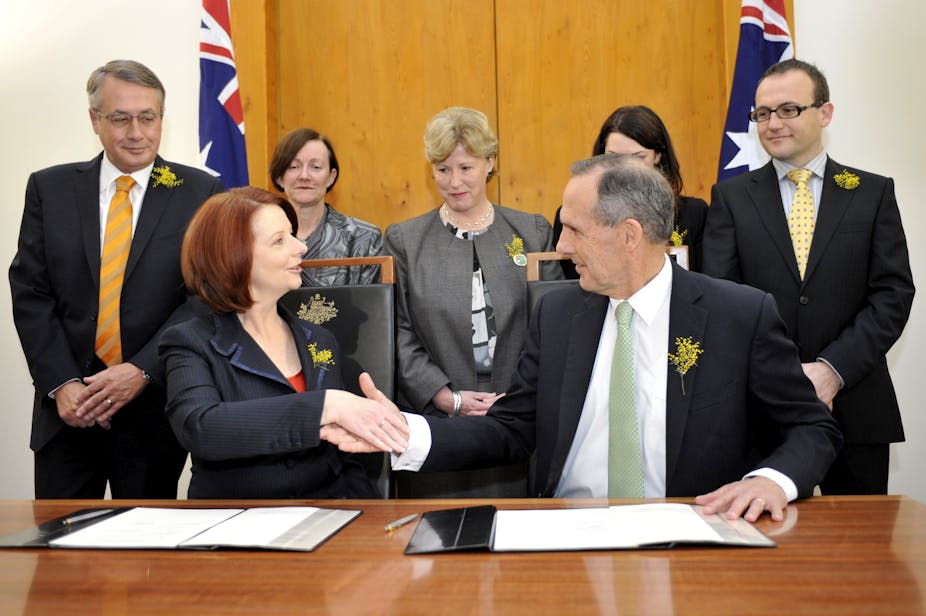Along with their sister parties in New Zealand, Germany, Austria and Luxembourg, the Australian Greens are among a small group of Green parties that have won more than 10% vote share at recent elections.
Like many other Green parties, the Australian Greens’ steady electoral growth has led them closer to the centre of political power in recent years.
Since the mid-1990s, Green parties have cooperated with other parties – in most cases with parties of the centre-left – in coalitions at a national level in Belgium, the Czech Republic, Finland, France, Italy, Germany, Ireland, the Netherlands, New Zealand and Sweden. Being part of a governing coalition has brought with it benefits - not least in the form of unprecedented opportunities for these parties to influence policy.
However, it also presents Green parties with new challenges and brings to the fore their seemingly contradictory relations with their coalition partners.
Green parties struggle to maintain their identity
For any small party, being in coalition is difficult. Cooperating with (or in) a government is a balancing act and no matter how much they achieve, parties with only a few seats usually need to compromise on much of their platform.
Over time, this can threaten the party’s distinctiveness, becoming an electoral liability. As a result, Green parties in coalition, like many other small parties, have had to work hard to retain their distinct identity.
Sometimes the need to assert their identity leads these parties to end their coalition early, as the Australian Greens did in February. At times – like in Finland in 2002, when the Greens left a coalition government over plans to build a nuclear power plant or in New Zealand (also in 2002) when they walked out of parliament because of a dispute with Labour on the release of genetically modified organisms – this appears to have paid off and they have ended up gaining votes.
At other times – like for the Walloon Greens in 2003 or the Czech Greens in 2010 – it has not, being too little too late for potential Green voters.
Getting into the habit
Life in coalition is particularly difficult for Green parties because their vote-base tends to be relatively weak. This is the case because it tends to take a few elections for a voter to become strongly attached to a party. For Green parties in opposition, this has meant that their growth has tended to be incremental, as they slowly build a larger and more robust support base.
For Green parties in coalition - which usually enter those coalitions on the back of an electoral gain - it presents a challenge. The flipside of winning new voters (as the Australian Greens did in 2010) is that these votes will be particularly difficult to hold on to in the face of the compromises made necessary by hard business of coalition. This is exacerbated by the fact that Green voters, on average, are younger and therefore even less likely to be strongly attached to the party (or any party).
Compounding these challenges is the fact that some of the policy problems that Green parties aim to resolve are particularly difficult. Policies to address climate change in particular require the balancing of high medium-term costs against strong short-term interests.
Partners or competitors?
All of this occurs as the Greens deal with coalition partners who are often less allies than rivals. Large centre-left parties often fish from the same pool of voters and compete on similar issues as the Greens. As a result, the Green parties are very often seen as a threat to mainstream centre-left parties and vice versa.

While being a junior coalition partner to their main electoral rival is challenging, perhaps the only situation more difficult than this is when they are in opposition and free to hoover up the votes of disaffected Green voters. Some of the worst electoral results that Green parties have experienced after being in coalition (like in Ireland in 2011 and the Netherlands in 2012) have occurred when their major centre-left rival has been in opposition.
Overall, although cooperation between Green parties and other parties happens at local, regional and national levels across advanced democracies, this relationship is typically characterised by intense rivalry.
What now for Green parties?
As a result of these challenges – maintaining a distinct identity, holding on to new, weakly-attached voters, and competing with the larger electoral rivals, either within the coalition or outside it – it has been difficult for Green parties to make gains at post-coalition elections. Some of these defeats have been modest. Others, like for the Irish, Czech and Flemish Greens, have meant that they have lost all of their seats in parliament.
However, some have shown that it’s not impossible to make gains after coalition. Green parties have managed this twice in Finland, once in Germany and once in France (albeit losing seats at the same time in this case). They have also managed to do so at times in Sweden and New Zealand, where they were emerging from a support arrangement similar to the Australian Greens’.
While it will be a challenge for the Greens to maintain their 2010 vote share at this Australian federal election – not to mention hold on to Adam Bandt’s seat of Melbourne – they might take comfort from the fact that even on the occasions when Green parties have suffered setbacks, they have both persisted and continued to grow. This is partly because their issues – climate change least of all – are not going away.

